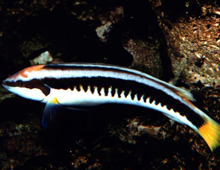Lord Howe Island

Wideband anemonefish, Amphiprion latezonatus
The Wideband anemonefish differs from its other clownfish relatives in the fact that it has a large white band in the center of its body. Like the McCullochi clownfish, the Latezonatus clownfish has only recently become available to aquarium hobbyists due to unprecedented success by marine aquaculturists. The natural range of the Wideband anemonefish extends from Southern Queensland to Northern New South Wales and Lord Howe Island.
LEARN MORE
McCullochi clownfish, Amphiprion mccullochi
Once rarely displayed in public aquariums, the McCullochi clownfish has recently become available to aquarium hobbyists around the world. Like other species of clownfish, the McCullochi clownfish lays a patch of bright orange eggs at regular intervals, usually in close proximity to its host anemone. Both parents care for the developing embryos and can be seen carefully tending the eggs and fiercely protecting them from potential predators.
LEARN MORE
Comb wrasse, Coris picta
Comb wrasses are named for the comb-like markings on their side. These fish are rarely displayed in public aquariums. The DWA has displayed this species since 1994. This sub tropical fish can be found in coastal waters of Southeastern Australia, Lord Howe Island, and New South Wales. It feeds on small crabs and shrimp and the juveniles may clean other fishes.
LEARN MORE
Painted goldie anthias, Psuedanthias pictilis
The Painted goldie anthias, also known as the Pictilis anthias, like other members of the sea bass family, are hermaphrodites. The brightly colored males can be seen battling for their harem of less colorful females. In the absence of a male, the most dominant female can become a male. Painted goldies feed on zooplankton and floating algae and often hide in crevices or caves in the reef.
LEARN MORE
Spectacled angelfish, Chaetodontoplus conspicillatus
The DWA’s collection of coral reef fishes is internationally recognized for rarely-exhibited species. Marine angelfish (not to be confused with freshwater angelfish, which are cichlids) are a specialty and the Spectacled angelfish, also known as the Conspiculatus angelfish because of the “spectacle-like” rings around its eyes, is one of the most admired. This fish is found in the subtropical waters of Lord Howe Island and is considered rare in the aquarium industry. In 1994, the DWA was the first aquarium in the world to feature a Lord Howe Island exhibit.
LEARN MORE

